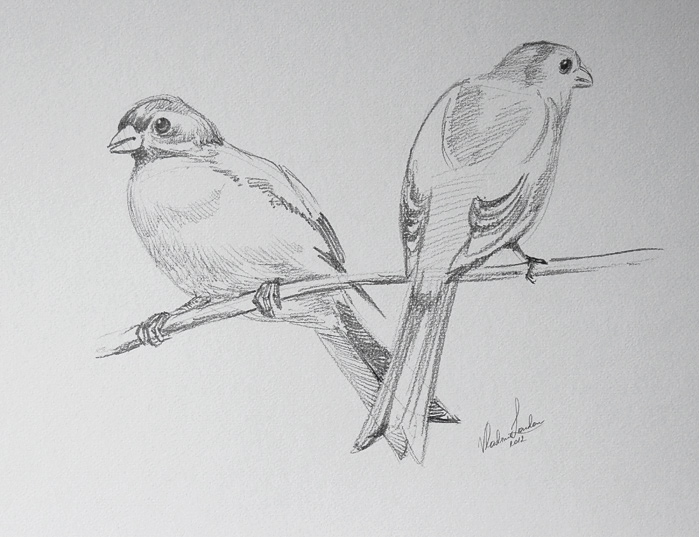Discover How to Draw Birds
In this video lesson, you will discover How to Draw Birds on example of making a couple of quick realistic sketches of a bird from two points of view.
Enroll in the Drawing Academy Course
Pay once - Enjoy forever!
Only $297
How to Draw Birds and Other Animals
The best way to learn how to draw birds and other animals is by making quick sketches from nature. For that purpose, you can have a sketchpad with a firm cover and practice rapid drawings on a daily basis. With time and practice your drawing skills will improve. You will train your eyes and hand to draw realistic pictures in just few minutes. It is also good practice to draw birds and other animals from memory at home.
How to Draw Birds – First Steps
I make a thin outline of the bird’s main shapes, its head, body and tail. The rough outline is very stylized. The head is represented by a smaller oval; the body is marked as a much bigger oval and the tail is depicted in straight lines.

The bird is sitting on the twig. So we need to establish how the body is positioned in relation to this twig.
At this step, we are more interested in the overall proportions of the bird, such as: how many times its head is bigger than its body, how round the body oval is, and how long its tail is. We also pay attention to the bird’s pose. We look at the angles of its body, head and tail.
This preliminary outline is done in thin lines that are easy to erase. At this stage it is easy to fix any mistakes, reposition the bird’s body or make it smaller or bigger, if required.
How to Draw Birds – Next Steps

When I am happy with the bird’s size, position and proportions, I am continuing on in bolder lines. It is time to start depicting smaller details. The beak, crown, chin and other features are very characteristic to certain species of birds.
The bird’s eye has a very different texture to its feathers. I render the eye in high contrast between the reflected spot of light and the dark eyeball.
The highest density of the bird’s feathers is on its head, neck, chin and throat. I render these areas in short pencil strokes.
We look on the bird from below. The outline of the bird’s back is done in a few laconic lines. Its wings are folded and appear quite slim from this point of view.
The bird’s breast is clearly visible. It is covered with small feathers, which are called, coverts. The main purpose of these feathers is to insulate the body and also streamline its shape during flight.
I draw the bird’s legs in darker and bolder lines to depict its different texture. This bird has anisodactyl, a distinctive arrangement of its feet, which is having its first toe directed backwards and its other three toes directed forwards. This is common in songbirds and other perching birds. Such birds have a unique foot structure. It enables them to grip onto thin branches and twigs. Some species can even grasp vertical rocks and tree trunks.
Each toe can be moved independently of the others. The leg tendons pinch and tighten under the bird’s weight when it lands on a branch. Such a grasp is strong enough to hold birds tightly to their perch even when they sleep.
How to Draw Birds – Second Sketch
I will make another sketch of the same bird from a different point of view. This time, the bird will be turned to the right hand side with its back turned to the viewer.
Once again, I start with the general shape of the bird, outlining its body, head and tail.
The bird sits on the same twig, so the bird’s body is located just above the twig.
When the general proportions are done, I can go into smaller details, like the shape of the beak and the position of the bird’s eye.
This is a very quick sketch that will have limited tonal rendering. Soft pencil is ideal for such sketches. It gives a wider range of tonal values and graphite marks can be very dark if necessary pressure is applied on the pencil.
The pattern of the wing feathers is done in a few quick patches. Curved lines describe the three-dimensional shape of the folded wings. Tones of primaries and secondaries feathers of the wing are much more prominent on this sketch compared to the bird’s mantle and coverts.
The feathers of the tail, which are called, rectrices, are also done in bold and strong pencil strokes.





Comments are closed.